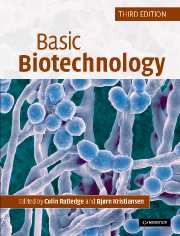Book contents
- Frontmatter
- Contents
- List of contributors
- Preface to the second edition
- Preface to the third edition
- Part I Fundamentals and principles
- Chapter 1 Public perception of biotechnology
- Chapter 2 Biochemistry and physiology of growth and metabolism
- Chapter 3 Stoichiometry and kinetics of microbial growth from a thermodynamic perspective
- Chapter 4 Genome management and analysis: prokaryotes
- Chapter 5 Genetic engineering: yeasts and filamentous fungi
- Chapter 6 Microbial process kinetics
- Chapter 7 Bioreactor design
- Chapter 8 Mass transfer
- Chapter 9 Downstream processing
- Chapter 10 Measurement, monitoring, modelling and control
- Chapter 11 Process economics
- Part II Practical applications
- Index
Chapter 2 - Biochemistry and physiology of growth and metabolism
Published online by Cambridge University Press: 05 June 2012
- Frontmatter
- Contents
- List of contributors
- Preface to the second edition
- Preface to the third edition
- Part I Fundamentals and principles
- Chapter 1 Public perception of biotechnology
- Chapter 2 Biochemistry and physiology of growth and metabolism
- Chapter 3 Stoichiometry and kinetics of microbial growth from a thermodynamic perspective
- Chapter 4 Genome management and analysis: prokaryotes
- Chapter 5 Genetic engineering: yeasts and filamentous fungi
- Chapter 6 Microbial process kinetics
- Chapter 7 Bioreactor design
- Chapter 8 Mass transfer
- Chapter 9 Downstream processing
- Chapter 10 Measurement, monitoring, modelling and control
- Chapter 11 Process economics
- Part II Practical applications
- Index
Summary
Introduction
The First Law of Biology (if there was one) could be: the purpose of a microorganism is to make another microorganism.
In some cases biotechnologists, who seek to exploit the microorganism, may wish this to happen as frequently and as quickly as possible; in other words they wish to have as many microorganisms available at the end of the process as possible. In other cases, where the product is not the organism itself, the biotechnologist must manipulate it in such a way that the primary goal of the microbe is diverted. As the microorganism then strives to overcome these restraints on its reproductive capacity, it produces the product which the biotechnologist desires. The growth of the organism and its various products are therefore intimately linked by virtue of its metabolism.
In writing this chapter, I have not attempted to explain the structure of the main microbial cells: the bacteria, the yeasts, the fungi and the microalgae. These are available in most biology textbooks and these should be consulted if there are uncertainties about cell structures. However, biology textbooks rarely explain the chemistry that goes on in the living cell (i.e. their biochemistry) in simple terms but, as the biochemistry of the cell is fundamental to the exploitation of the organism, it is important to be acquainted with the basic systems that microbial cells use to achieve their multiplication.
The biochemistry of the cell is therefore described as an account of the chemical changes that occur within a cell as it grows and multiplies to become two cells.
- Type
- Chapter
- Information
- Basic Biotechnology , pp. 25 - 54Publisher: Cambridge University PressPrint publication year: 2006
- 1
- Cited by



